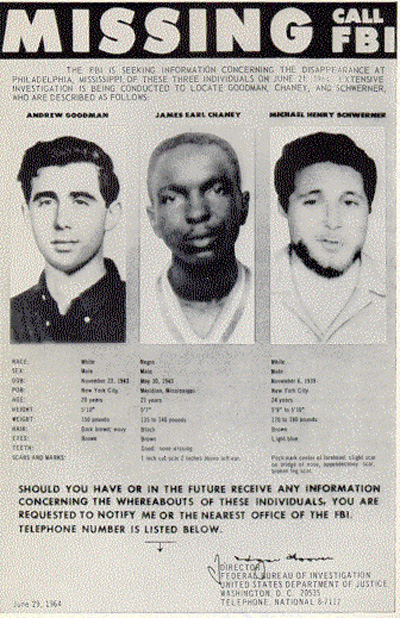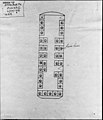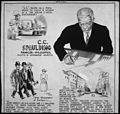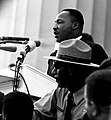Portal:Civil rights movement
The civil rights movement portal The civil rights movement was a social movement and campaign from 1954 to 1968 in the United States to abolish legalized racial segregation, discrimination, and disenfranchisement in the country. The movement had its origins in the Reconstruction era during the late 19th century and had its modern roots in the 1940s, although the movement made its largest legislative gains in the 1960s after years of direct actions and grassroots protests. The social movement's major nonviolent resistance and civil disobedience campaigns eventually secured new protections in federal law for the civil rights of all Americans. After the American Civil War and the subsequent abolition of slavery in the 1860s, the Reconstruction Amendments to the United States Constitution granted emancipation and constitutional rights of citizenship to all African Americans, most of whom had recently been enslaved. For a short period of time, African-American men voted and held political office, but as time went on Blacks were increasingly deprived of civil rights, often under the racist Jim Crow laws, and African Americans were subjected to discrimination and sustained violence by white supremacists in the South. Over the following century, various efforts were made by African Americans to secure their legal and civil rights, such as the civil rights movement (1865–1896) and the civil rights movement (1896–1954). The movement was characterized by nonviolent mass protests and civil disobedience following highly publicized events such as the lynching of Emmett Till. These included boycotts such as the Montgomery bus boycott, "sit-ins" in Greensboro and Nashville, a series of protests during the Birmingham campaign, and a march from Selma to Montgomery. At the culmination of a legal strategy pursued by African Americans, in 1954 the Supreme Court struck down the underpinnings of laws that had allowed racial segregation and discrimination to be legal in the United States as unconstitutional. The Warren Court made a series of landmark rulings against racist discrimination, including the separate but equal doctrine, such as Brown v. Board of Education (1954), Heart of Atlanta Motel, Inc. v. United States (1964), and Loving v. Virginia (1967) which banned segregation in public schools and public accommodations, and struck down all state laws banning interracial marriage. The rulings played a crucial role in bringing an end to the segregationist Jim Crow laws prevalent in the Southern states. In the 1960s, moderates in the movement worked with the United States Congress to achieve the passage of several significant pieces of federal legislation that authorized oversight and enforcement of civil rights laws. The Civil Rights Act of 1964 explicitly banned all discrimination based on race, including racial segregation in schools, businesses, and in public accommodations. The Voting Rights Act of 1965 restored and protected voting rights by authorizing federal oversight of registration and elections in areas with historic under-representation of minority voters. The Fair Housing Act of 1968 banned discrimination in the sale or rental of housing. (Full article...) Selected article -The Birmingham campaign, also known as the Birmingham movement or Birmingham confrontation, was an American movement organized in early 1963 by the Southern Christian Leadership Conference (SCLC) to bring attention to the integration efforts of African Americans in Birmingham, Alabama. Led by Martin Luther King Jr., James Bevel, Fred Shuttlesworth and others, the campaign of nonviolent direct action culminated in widely publicized confrontations between young black students and white civic authorities, and eventually led the municipal government to change the city's discrimination laws. In the early 1960s, Birmingham was one of the most racially divided cities in the United States, enforced both legally and culturally. Black citizens faced legal and economic disparities, and violent retribution when they attempted to draw attention to their problems. Martin Luther King Jr. called it the most segregated city in the country. Protests in Birmingham began with a boycott led by Shuttlesworth meant to pressure business leaders to open employment to people of all races, and end segregation in public facilities, restaurants, schools, and stores. When local business and governmental leaders resisted the boycott, the SCLC agreed to assist. Organizer Wyatt Tee Walker joined Birmingham activist Shuttlesworth and began what they called Project C, a series of sit-ins and marches intended to provoke mass arrests. (Full article...)General imagesThe following are images from various civil rights movement-related articles on Wikipedia.
Related portalsWikiProjectsSelected biography -
Charlotte L. Brown (1839–?) was an American educator and civil rights activist who was one of the first to legally challenge racial segregation in the United States when she filed a successful lawsuit against a streetcar company in San Francisco in the 1860s after she was forcibly removed from a segregated streetcar. Brown's legal action and the precedent it created led to additional challenges to segregation in San Francisco and within 30 years, California enacted legislation to make such segregation on streetcars illegal statewide. (Full article...)
Selected image - Missing persons poster created by the FBI in 1964, signed by the Director J. Edgar Hoover. Shows the photographs of Andrew Goodman, James Chaney, and Michael Schwerner. All three were found to have been later murdered by local White Knights of the Ku Klux Klan, and the Neshoba County Sheriff's Office as well as the Philadelphia, Mississippi Police Department were involved in the incident. Did you know?
TopicsSubcategoriesThings to doAssociated WikimediaThe following Wikimedia Foundation sister projects provide more on this subject:
Discover Wikipedia using portals
|
- Portals with triaged subpages from June 2018
- All portals with triaged subpages
- All portals
- Portals with no named maintainer
- Civil Rights Movement portal
- Random portal component with more available subpages than specified max
- Random portal component with 6–10 available image subpages
- Redirect targets of redirected portals with existing subpages
- History portals
- United States portals
- Portals needing placement of incoming links



















































